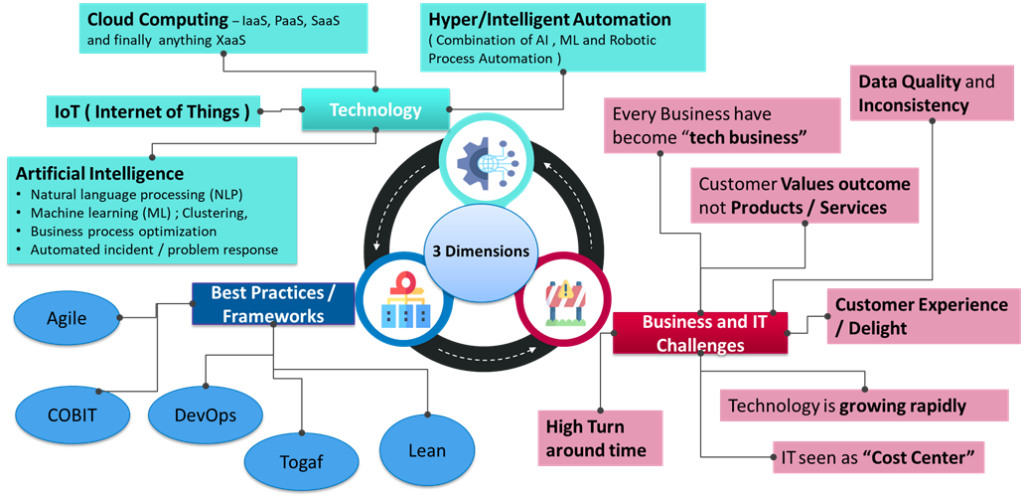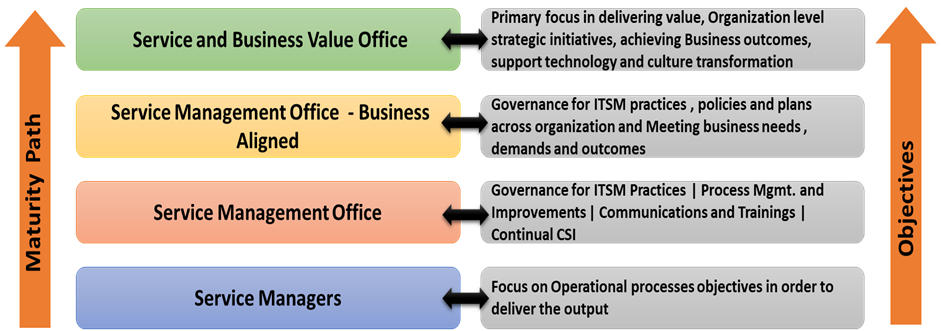This article explains how the Service Management Office (SMO) is evolving to its future state from its present form by adopting various IT service management (ITSM) best practices, methods, technology, and tools.
This article explains how the Service Management Office (SMO) is evolving to its future state from its present form. Read how here. #SMO #ITSM Click To TweetWhat is a Service Management Office?
The concept of the Service Management Office started in the early 2000s and was adopted in the US and UK regions in particular. Earlier, as part of the ITIL v1 introduction in the 90s, only Process Managers and Service Manager roles existed widely as part of governance and were adopted by many organizations as part of their ITIL implementations.
The Service Management Office is a governing body within an IT organization that primarily governs and manages ITSM practices and sets policies, standards, processes, and procedures to provide quality and value by delivering IT services to end-users and business functions.
Over the years, the Service Management Office has evolved along with the ITIL version releases.
How the Service Management Office has evolved in the last 20 years
| Years | ITIL Version Release | Service Management Office Evolution |
|---|---|---|
| 1989-95 | Government Information Technology Infrastructure Management (GITIM) - 30 volumes that include IT best practices | No SMO concept was available. |
| 2000-2004 | ITIL v2 released | No SMO concept was evolved, however process and best practices were governed and managed by process managers. |
| 2007 | ITIL v3 released | The beginning of the SMO model |
| 2011 | ITIL v3 revision, along with ITIL guiding principles in 2016's ITIL Practitioner Guide | The SMO matured to support all IT functions and delivery; needed value to the business |
| 2019 | ITIL 4 released - aligned ITIL with DevOps, Agile, and Lean | The SMO evolved to govern and support IT and across the organization/enterprise level from Operations to Strategy, with the primary focus on delivering value and achieving business outcomes |
Sources: ITIL – Wikipedia, History of ITIL | IT Process Wiki (it-processmaps.com)
Why the current-state SMO needs to evolve and the factors influencing the traditional SMO model

The maturity of SMO models

Future-state SMO – the “Service and Business Value Office”
The future-state Service Management Office can be termed the “Service and Business Value Office.” Its key objectives will be based on value creation and meeting business goals and outcomes.
The Service and Business Value Office is segregated into two levels:
- Service Value Office – Focusing on Value creation and delivery of quality services and needed experience to the end-users of IT and the Business. It also adopts the necessary technology and tools to enable Value Chain model practices.
- Business Value Office – Focusing on Business functions and demands, outcomes, and bridging the gap between IT and the Business through value reporting. In addition, it should provide Business Value Stream mapping services to meet Organization and Business initiatives, Goals, and Outcomes.
The future-state Service Management Office which is now a “Service and Business Value Office,” should evolve and cater to the following key areas:
- Governance of Business Value which includes Value Stream Services, Business Health & Value Reporting, and Communication & Escalation
- Contextualize Service Provisioning to cater to and design IT services based on Business requirements and demands
- Digital and Culture Transformation to enable the workforce to transform in line with new ways of working
- Value Chain model supported by guiding principles to deliver seamless ITSM services
- Govern Communities of Practices to have a clear structure, standards, and governance of all practices like ITIL, Agile, Lean and DevOps, Kanban, etc.
- Technology Adoption to enable key Value Levers like Service Optimization, Employee Digital Experience, and Automation of Services and to enable Artificial IT Service Management
- Service Experience to improve IT-driven business and employee experiences by implementing experience-level agreements.
There is a strong need for the current Service Management Office model and maturity to evolve to a future state that considers various influencing factors like Technology Transformation and Business and IT Challenges/Demands. The future-state Service Management Office models should not only focus on the standpoint of the service and transform into a “Product and Purpose”-based model; they should also have a major stake in business strategy by delivering the needed value and meeting business goals and demands.
If you liked this Service Management Office article, would you like to read something on IT mapping and service reliability?
Rahavendran RS
Rahavendran is an ITSM thought leader and Agile practitioner, ITIL® V3 Expert, ITIL 4 Foundation and Cloud Credential Certified ( PCSM ) professional with strong experience in providing quality ITSM solutions to customers from various business verticals.
Has vast experience in architecture of service management solutions, has lead team of process and tool consultants in designing and deploying ITSM processes at all layers from strategy to operational, defining governance models, continual improvement initiatives and corresponding tools for various clients across the globe.

